Tobacconists: cigarette and tobacco shops in the past
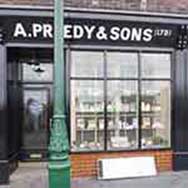
Towards the middle of the 20th century, shops specialising in tobacco sales began to disappear as the understanding of the health implications of smoking grew. This page describes those tobacconist shops and the increasingly large number of other places where tobacco products could readily be bought.
____
By the webmaster, based childhood observations, firsthand contributions and additional research
Tobacco smoking was so much a way of life while I was growing up in the 1940s and 1950s that there was no difficulty at all in finding somewhere to buy tobacco products. In particular there were showcases of them on public display for all to see.
Tobacconist shops
There were shops, known as tobacconists, dedicated to selling just tobacco products, and they clearly made a good living. Some were in chains, like Lewis's, but there were also individual tobacconist proprietors.
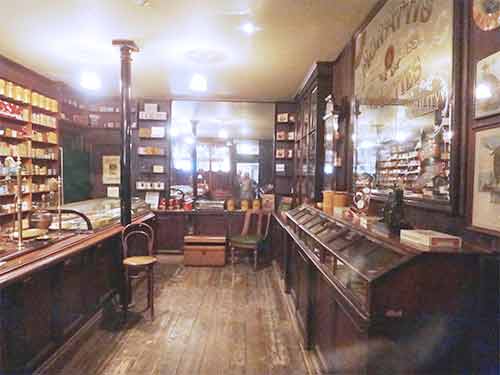
Inside a tobacconist shop. This shop is now part of Winchester City Museum and is as it was when it ceased trading, still in its original location.
As the image shows, dedicated tobacconists could be quite large shops. This one has a counter on the left that the shop assistant would stand behind, shelves behind him which he would take down and weigh out their contents to customers' requirements. You can just discern the scales on the far left. Note the cupboards under the counter and the obligatory bent-wood chair in front for customers to use if they needed to wait. There is another at the back.
On the right are display cases with cupboards underneath. The following is an image of just one. I suspect that you would never have imagined that so many different types of tobacco would be available. It was almost a status symbol to be committed to one particular brand.
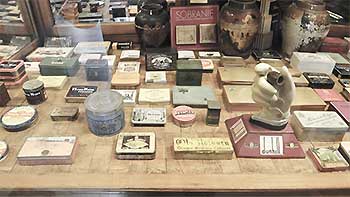
One of many display cases in a tobacconist shop
Note the dark wood everywhere, livened up somewhat by the large mirrors. These mirrors were common in the tobacconists and pubs that I knew. They always had elegant advert text painted on them.
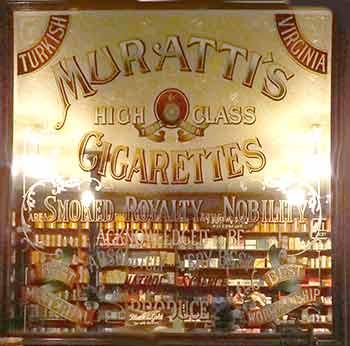
Typical shop mirror with advert writing on it, but also showing reflections of the goods on display
Newsagents and pubs
Most newsagents also sold the more popular cigarette brands alongside their newspapers and magazines, as did pubs alongside their drinks.
However, newsagents and pubs did not carry anywhere near the same range of stocks as the specialist tobacconists.
Cigarette sales in grocery shops
contributed by Jan Clifford
During my childhood in the 1940s and early 1950s, it was not at all odd that a grocery shop had a glass container - much like a large open top fishbowl - on the counter from which loose cigarettes, mostly 'Players' brands, could be bought individually. This allowed people to buy the few 'smokes' they would get through during their working day.
Cigarette vending machines
Cigarette vending machines were also in public places, particularly in railway stations - although of course they were often empty during World War Two.
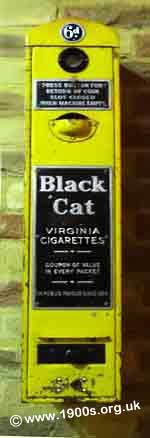
Cigarette vending machine, photographed in Milton Keynes Museum, showing 6d, known as sixpence, as the price of a packet of cigarettes.
Gradually in the later part of the century, dedicated tobacconists and cigarette vending machines began to disappear, as supermarkets and newsagents took over these roles.
Prices of cigarettes, 1939 and in WW2 UK
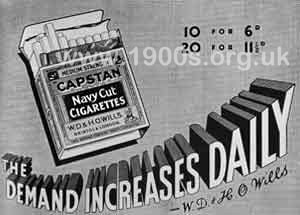
Advert showing the price of cigarettes in 1939
What is really significant about this advert is that it shows the prices of cigarettes in 1939 just before the outbreak of war:
- A packet of 10 cigarettes cost 6d, i.e. 6 old pennies, and
- A packet of 20 cigarettes cost 11½d, i.e. 11½ old pennies.
Clearly it was cheaper in the long run to buy the larger packet! Another advertising gimmic.
The following contribution shows that cigarette prices were kept constant during the Second World War.
contributed by Douglas Adam, recollections
During the war, store prices of cigarettes were 10 for sixpence (5p), 20 for 11pence ha'penny (just under 10p. How's that for inflation!?
| sources | webmaster | contact |
Text and images are copyright
If you can add anything to this page or provide a photo, please contact me.



